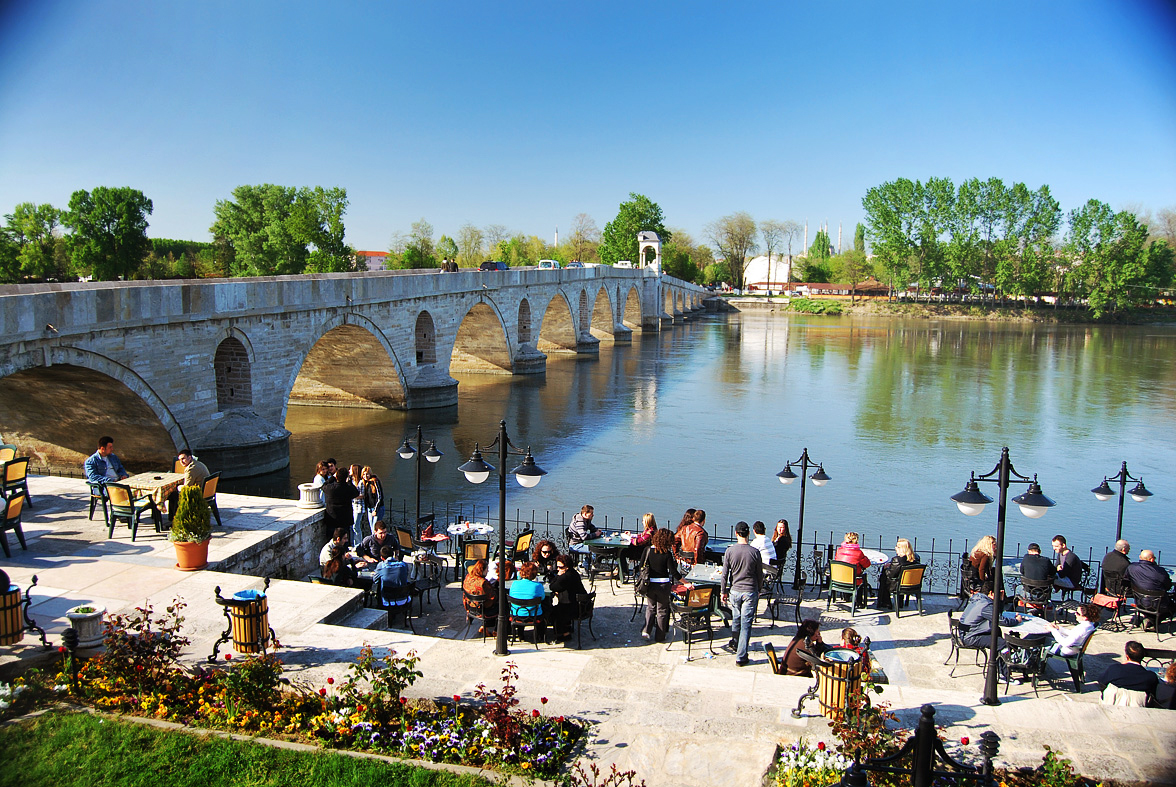S
Edirne
Edirne is a city in the Turkish region of East Thrace, close to its borders with Greece and Bulgaria. Edirne served as the third capital city of the Ottoman Empire from 1363 to 1453, before Constantinople (present-day Istanbul) becamethe empire's fourth and final capital. At present, Edirne is the capital of Edirne Province in Turkish Thrace. The city's estimated population in 2010 was 138,793, up from 119,298 in 2000.
Situated 7 km (4.3 mi) near to the Greek and 20 km (12 mi) to the Bulgarian border, Edirne is famed for its many mosques, domes and minarets. The Selimiye Mosque, built in 1575 and designed by Turkey's greatest master architect, Mimar Sinan (c. 1489/1490–1588), is one of the most important monuments in the city. It has the highest minarets in Turkey, at 70.90 m (232.6 ft) and a cupola 3 or 4 ft (0.91 or 1.22 m) higher than that of Hagia Sophia, the Byzantine Orthodox Cathedral (now museum) in Istanbul. Carrying the name of the then reigning Ottoman Sultan Selim II (r. 1566–1574), this mosque futures Turkish marble handicrafts, and it is covered with valuable tiles and fine paintings. Another notable mosques are Eski Cami (Old Mosque), and Burmalı Cami (Serpent Mosque), aka Üç Şerefeli Mosque.
Edirne has three historic covered bazaars: Arasta, next to Selimiye Mosque, Bedesten next to Eski Cami and Ali Paşa Çarşısı (Ali Pasha Bazaar).
Besides the mosques, there are visitor attractions in Edirne, all reflecting its rich past. The most prominent place being the Edirne Palace (Ottoman Turkish: Saray-ı Cedid-i Amire for "New Imperial Palace") in Sarayiçi quarter, built during the reign of Murad II (r. 1421–1444). Although the buildings of the palace and its bath (Kum Kasrı Hamamı) are in ruined form, the palace gate and the palace kitchen facility are restored. The Kasr-ı Adalet ("Justice Castle"), built as part of the palace complex, stands intact next to the small Fatih Bridge over the Tunca river.
Another notable building in the area is the Trakya University's Bayezid II Külliye Health Museum, an important monument with its complex construction comprising many facilities used in those times.
The Balkan Wars Memorial Cemetery is located close to the Edirne Palace, with an unknown soldier monument futuring an Ottoman soldier in front of its entrance.
The historic Grand Synagogue of Edirne, abandoned and ruined, was restored and re-opened in March 2015. A Roman Catholic and two Bulgarian Orthodox churches are found in the city.
Edirne has several historic arch bridges crossing over the rivers Meriç and Tunca, which flow around west and south of the city.
There are caravansaries, like the Rustem Pasha and Ekmekcioglu Ahmet Pasha caravansaries, which were designed to host travelers, in the 16th century.
The historic Karaağaç railway station hosts today, after redevelopment, the Trakya University's Faculty of Fine Arts in Karaağaç suburb of Edirne. Next to it, the Treaty of Lausanne Monument and Museum are situated.
Edirne is home to the traditional oil-wrestling tournament called Kırkpınar. Held every year in June, it is considered to be the oldest active sport organization after the Olympic Games that were refounded only after centuries of inactivity.
Another international festival in Edirne is Kakava, a celebration of Roma people held on May 5 each year.
A cultural partnership with Lörrach in Germany has been started in 2006. The goal is to exchange pupils and students to improve their cultural skills and understanding.
Edirne is well known for the local dish "ciğer tava" (breaded and deep-fried liver) served often with cacık, diluted yogurt with chopped cucember.
* Source: Wikipedia.org
PICTURES OF EDIRNE

